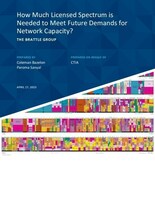WASHINGTON, April 17, 2023 /PRNewswire/ -- America's wireless operators do not have enough exclusive-use, full-power licensed spectrum to meet the future demand for wireless broadband, according to a new Brattle Group report commissioned by CTIA. Policymakers must allocate an additional 400 megahertz of 5G-ready spectrum by 2027, and over 1,400 megahertz by 2033, to ensure U.S. 5G networks can meet their potential and secure American leadership in wireless innovation.
The report, "How Much Licensed Spectrum is Needed to Meet Future Demands for Network Capacity," examines potential tools operators can leverage to meet the anticipated capacity gap as consumer demand for 5G skyrockets. Even accounting for extremely optimistic improvements in spectral efficiency and additional infrastructure deployment, the analysis makes clear that additional 5G-ready spectrum is the only realistic way to meet projected growth in demand.
"The inability to provide adequate capacity to support projected usage growth would lead to poor customer experience, network overload, and otherwise risk forfeiting U.S. leadership in 5G and beyond," said Dr. Coleman Bazelon, Principal, The Brattle Group.
"Coleman's report helps define the risk of continued inaction on spectrum. We need more 5G spectrum to meet increasing data demand, support new innovation and enable the speeds and capacity necessary to fuel future innovation," said CTIA President and CEO Meredith Attwell Baker. "We now have a target for future action. More full-powered, exclusive-licensed spectrum is key to both our economic and national security. Letting auction authority lapse sent the wrong signal to the rest of the world. We need to restore it quickly with a defined set of new auctions."
"Our analysis indicates that, given the pace of the demand growth, technological solutions and deploying more cell sites are insufficient to ease the capacity constraint currently facing the U.S. cellular networks. Spectrum availability is the key to solving the capacity shortfall and Congress, the FCC, and other policymakers should work to allocate more spectrum for licensed mobile uses in a timely manner," said co-author Dr. Paroma Sanyal, Principal, The Brattle Group.
The report's findings underscore the growing risk to America's 5G and innovation leadership. Currently the United States has no plan to allocate more mid-band spectrum for 5G and Congress allowed the FCC's ability to auction spectrum for licensed, commercial use, to lapse for the first time in its 30-year history. This inaction in the face of a looming spectrum deficit contrasts with other countries: Today the United States trails other countries in 5G spectrum by 378 megahertz on average—a deficit expected to grow to 518 megahertz in five years.
"Spectrum repurposing is a difficult and time-consuming process, and unfortunately there is not an adequate pipeline of spectrum anticipated to meet wireless demand today. Our analysis gives a glimpse of the stunted wireless future if policymakers do not act," said Dr. Bazelon.
SOURCE CTIA

WANT YOUR COMPANY'S NEWS FEATURED ON PRNEWSWIRE.COM?
Newsrooms &
Influencers
Digital Media
Outlets
Journalists
Opted In






Share this article